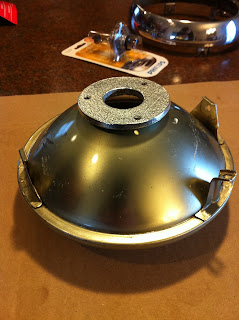As I discussed earlier, I wanted to try and sew up the headlight portion of the project in my next installment of the blog. Also, I wanted to try JB Weld the throttle cables which were broken on the plastic tubes coming out of the right hand controls. Another little thing that I did was basically chopping off the mirror that was JB Welded into place by the previous owner in a manner that made the mirror completely ineffective, and then chopping off the nub of a mirror that had also been JB welded into place and then broken off at some point.
The first step in the cleaning up of the headlight housing was to clean up the rust. To accomplish this I used a Black & Decker 3" fine wire wheel mounted to a drill.
This did a pretty good job as you can see in the below picture which I took mid process.
In the picture below you can see the masking job I did on the outside of the headlight housing.
Here is a shot of the Primer coat on the inside of the headlight assembly.
After that dried I applied the coats of gloss "canvas white" to the inside of the housing.
The next thing that I wanted to address is the issue with the throttle cables. As you can see in the picture below, the plastic has broken where the threading to adjust the tension on the throttle cables goes into.
This has been causing issues with my ability to be able to finess the throttle when I have been trying to start the bike. The throttle response is sluggish and also sometimes sticks. The trick with JB Welding these was going to be to not have the stuff squeeze into the tube and then "weld" the cable into place. It was worth the risk, as I was getting nowhere with getting the bike to idle properly without good cables and the set would be $60-ish for the set from Suzuki if I needed to buy new ones. So with nothing to lose I figured I'd give it a try.
The first step, which I didn’t get a picture of was to get enough of a bead on the broken end to hold it together and not squeeze in. I let that se overnight and then in the morning once it was holding pretty well, I coated the whole exterior with more JB Weld. If you look carefully at the picture you can see the raised area where the initial bead was under the JB Weld coating.
The good news is that throughout the process I managed to have no interference of JB Weld with the cable so they still slide freely! I might look into the proper way to lube them if possible to the to help them slide even better! The true test will be once I get them mounted back on the bike and see how they hold up (stay tuned for that).
Here is another thing that has always annoyed me about the bike. This rearview mirror on the left was JB Welded into place by the previous owner and the way it is set you can’t even adjust it to see behind you! I can tell the same thing had happened on the right hand side too but that one had broken off already.
Even if I could have removed the mirror, which I couldn’t, they aren’t to my taste so I hack sawed them flush with the controls and filed the smooth on both sides. In the pictures you can see what had happened. The original mirrors must have stripped out and it looks like they drilled out the holes filled them with JB Weld and then stuck the mirrors in the holes. I’m not sure that I will use those mounting points in the long run but if I do I will consult my machinist friend and we will do it the right way. On a side note, the irony that I am bitching about someone’s use of JB Weld when I have used it in my last two blog updates is not lost on me!


I did identify one thing that I might have swayed my direction on what will be hapening with this bike. This bike has a 19" front wheel and an 18" rear wheel which I still have to confirm but I am pretty sure that means I have a 1979 Suzuki GS425L not an "E." The "L" was a chopper wannabe and I have to see what the differences are in the chassis but it there is a huge difference that swings it away from being a sporting prospect, I may be going in a bobber direction or perhaps just a refresh and keeps stock mindset instead of a cafe racer direction. Kind of sad, but I think if in the end I am able to keep an old bike on the road everyone wins!
That's about the extent of what I accomplised before I delve into my work week (Thursday - Sunday this week) but I should mention a couple of great things that happened this week as well not specifically related to the bike
1. I was able to work on the bike at night with the garage door open for the first time this year!
2. I took the SV650s for its first ride of the year today! Awesome!
Till next time everyone take care!











































